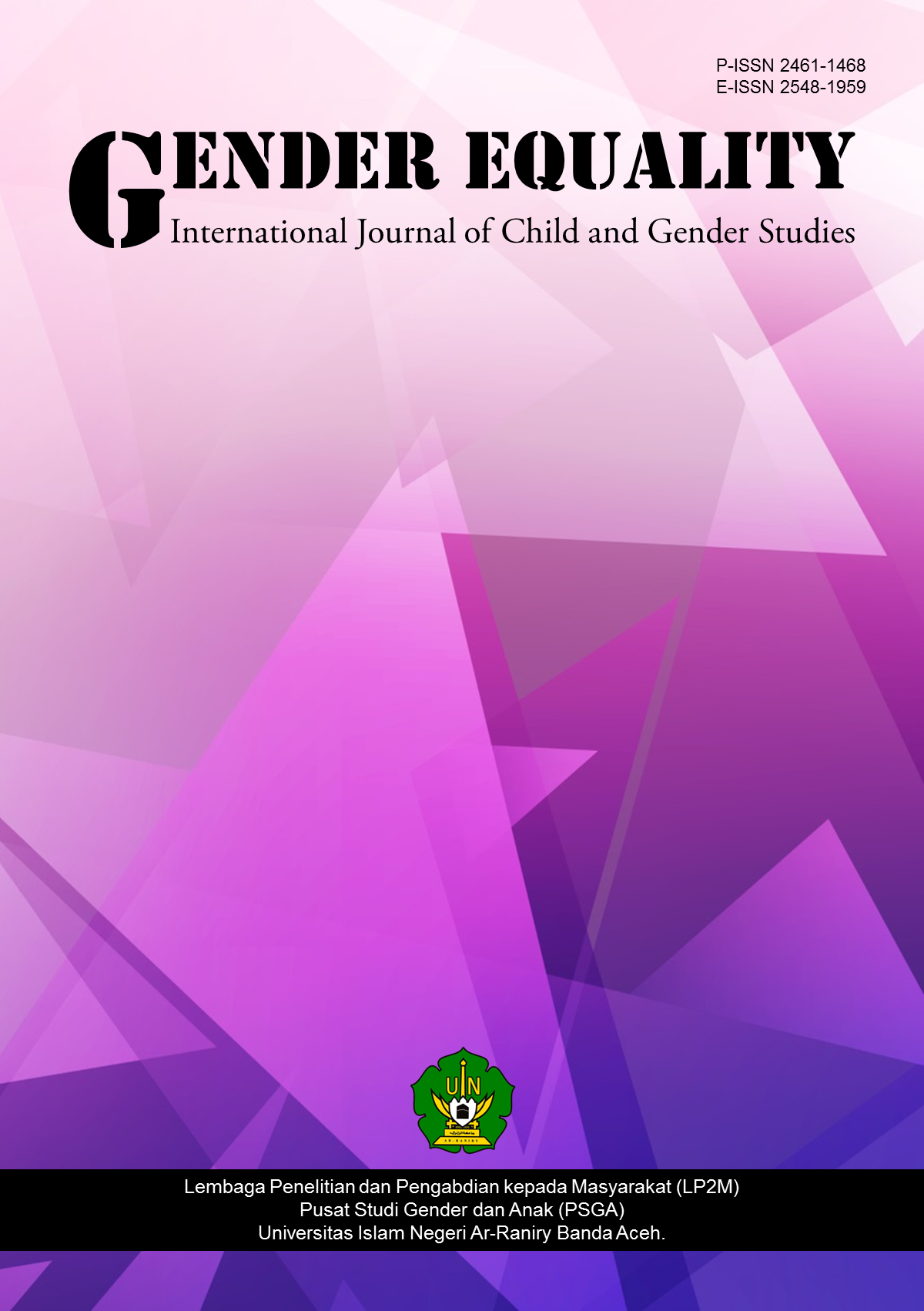Men's skincare trends: Korean wave hyperreality media men's beauty standards
DOI:
https://doi.org/10.22373/equality.v10i2.25075Keywords:
Gender, Hyperreality, Men's SkincareAbstract
The desire for a white and smooth face is not only a woman's need, but has become a man's need as well. This new phenomenon is influenced by the globalization of the Korean wave, which has created contemporary cultural standards. Such as the increased need for facial skin care products among men. Therefore, this paper discusses how the development of the Korean Wave affects men's skincare needs that are provided through Instagram. It even leads to the emergence of a new hyperreality that replaces the previous cultural standard. Hyperreality is the result of postmodernism, which makes the role of media a source of new human needs. The preparation of this paper is through the netnography method and literature review. The netnography method itself is a development of ethnography that uses Internet media to find information and connect with informants. Netnography helps research to examine social phenomena that appear in the Internet world, and has special methods in interviewing and validating information data obtained from Internet media. This paper shows that Somethinc's local product is a symbol of hyperreality that shifts the special needs of one gender to a common need raised by the globalization of the Korean Wave at this time. The new standards of life brought by the media show that the media has penetrated human life. It has even become a new standard or a standard for the continuation of life.
References
Anam, M. S., Warastri, A., & Dyorita, A. (2020). Motivasi Penggunaan Skincare Ditinjau Dari Self-Image Pada Pria Di Yogyakarta (Doctoral dissertation, Universitas ‘Aisyiyah Yogyakarta).
Asmanidar. (2017). Pergeseran budaya permainan anak di Aceh: Suatu tinjauan sosiologis antropologis. Gender Equality: International Journal of Child and Gender Studies, 3(2), 88–99.
Bungin, B. (2017). Penelitian kualitatif: Komunikasi, ekonomi, kebijakan publik, dan ilmu sosial lainnya. Jakarta: Kencana.
Hine, C. (2000). Virtual ethnography. Sage Publications Ltd.
Irawan, V., & Widjaja, A. W. (2011). Pengembangan model perilaku konsumen pria dalam membeli produk perawatan kulit (skin care) di Indonesia. ULTIMA Management, 3(1), 16–30. https://doi.org/10.31937/manajemen.v3i1.173
Istiqomah, A., & Widiyanto, D. (2020). Ancaman budaya pop (pop culture) terhadap penguatan identitas nasional masyarakat urban. JURNAL KALACAKRA: Ilmu Sosial Dan Pendidikan, 1(1), 18. https://doi.org/10.31002/kalacakra.v1i1.2687
Keshia, Y. T. C., Sesilya, & Zane, V.-G. (2020). Determinant factors in purchasing Korean skin care products. SHS Web of Conferences, 76, 01021. https://doi.org/10.1051/shsconf/20207601021
Kim, E. M., & Ryoo, J. (2007). South Korean culture goes global: K-Pop and the Korean wave. Korean Social Science Journal, 34(1), 117–152. Retrieved from http://kossrec.org/board/imgfile/KSSJ%20Vol.34.no.1(Eun%20Mee%20Kim&Jiwon%20Ryoo)).pdf
Kozinets, R. V. (2015). Netnography: Redefined. Sage.
Pemita, D. (2015). Puaskan penggemar, drama legendaris Winter Sonata dibuat sekuel. Liputan6.com. https://www.liputan6.com/showbiz/read/2213915/puaskan-penggemar-drama-legendaris-winter-sonata-dibuat-sekuel
Pratiwi, D., Suroso, S., & Endri, J. (2020). Implementasi metode simple additive weighting dan machine learning untuk rekomendasi produk skin care berbasis Android. Jurnal Media Informatika Budidarma, 4(4), 1162–1169. https://doi.org/10.30865/mib.v4i4.2389
Purnomo, D. C., Yanti, M., & Widyassari, A. P. (2021). Pemilihan produk skincare remaja milenial dengan metode simple additive weighting. Jurnal Ilmiah Intech: Information Technology Journal of UMUS, 3(01), 32–41.
Putri, I. P., Liany, F. D. P., & Nuraeni, R. (2019). K-Drama dan penyebaran Korean Wave di Indonesia. ProTVF, 3(1), 68. https://doi.org/10.24198/ptvf.v3i1.20940
Sanny, L., Arina, A. N., Maulidya, R. T., & Pertiwi, R. P. (2020). Purchase intention on Indonesia male’s skin care by social media marketing effect towards brand image and brand trust. Management Science Letters, 10, 2139–2146. https://doi.org/10.5267/j.msl.2020.3.023
Septyan, D. A. (2022). Peluang pasar: Makanan Korea. Ukmindonesia.Id. https://ukmindonesia.id/baca-deskripsi-posts/peluang-pasar-makanan-korea/
Setiawan, R. (2014). BoA, sang ratu K-Pop penakluk Jepang. Suara.com. https://www.suara.com/entertainment/2014/11/05/090000/boa-sang-ratu-k-pop-penakluk-jepang
Sugiyono, P. D. (2019). Metode penelitian pendidikan (kuantitatif, kualitatif, kombinasi, R&D dan penelitian tindakan). Bandung: Alfabeta.
Tarigan, M. (2017). 95 persen pria peduli penampilan kulit mereka. Tempo.co. https://gaya.tempo.co/read/1040154/95-persen-pria-peduli-penampilan-kulit-mereka
Tjiptono, F. (2008). Strategi pemasaran. Andi Offset.
Valentina, A., & Istriyani, R. (2017). Gelombang globalisasi ala Korea Selatan. Jurnal Pemikiran Sosiologi, 2(2), 71. https://doi.org/10.22146/jps.v2i2.30017
Zahira, N. (2021). Kepentingan Indonesia menaikkan tarif impor produk kosmetik (studi kasus: Kosmetik asal Korea Selatan). JOM FISIP, 8(II), 1–23.
Zulkarnain, S. I., & N. F. (2018). Perbedaan gaya bahasa laki-laki dan perempuan pada penutur bahasa Indonesia dan Aceh. Gender Equality: International Journal of Child and Gender Studies, 4(1), 159–172.
Downloads
Published
Issue
Section
License
GENDER EQUALITY: International Journal of Child and Gender Studies allows the author(s) to hold the copyright and to retain the publishing rights without restrictions. Authors who publish with this journal agree to the following terms:
- Authors retain copyright and grant the journal right of first publication with the work simultaneously licensed under a Creative Commons Attribution License that allows others to share the work with an acknowledgment of the work's authorship and initial publication in this journal.
- Authors are able to enter into separate, additional contractual arrangements for the non-exclusive distribution of the journal's published version of the work (e.g., post it to an institutional repository or publish it in a book), with an acknowledgment of its initial publication in this journal.
- Authors are permitted and encouraged to post their work online (e.g., in institutional repositories or on their website) prior to and during the submission process, as it can lead to productive exchanges, as well as earlier and greater citation of published work.



